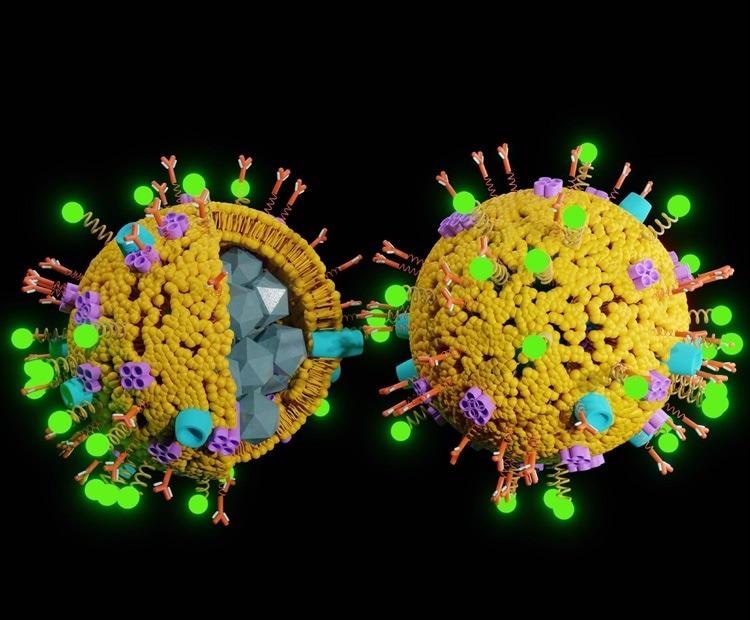Small (or short) interfering RNA (siRNA) is the predominant RNA interference (RNAi) tool used for instigating short-term silencing of protein-coding genes. Simply put, these are naturally occurring molecules that ‘silence’ genes that encode specific proteins.

Image Credit: Love Employee/Shutterstock.com
This means that siRNA demonstrates significant potential for therapeutic use, given its capacity to control protein levels. However, one of the main drawbacks with siRNA is that researchers have had difficulty transmitting the molecules to the site of action in the body, the cytosol target of cells, as a result of the body’s immune response.1
To overcome the challenges associated with siRNA delivery, a team of researchers in the Netherlands has been working to develop hybrid nanoparticles that protect and transmit siRNA into target cells.
Hybrid Nanoparticles
The system the team is using relies on a combination of liposomes and extracellular vesicles (EVs), which offer unique properties that package and protect siRNA against enzyme degradation.
The hybrid nanoparticles have a hydrophobic coating, thanks to the amphiphilic nature of the liposomes, which provides adequate shielding against the body’s immune response. Additionally, as EVs can easily pass through the outer membrane of a cell, the siRNA can be delivered to the site of action as intended.
The method employed by the researchers uses a dehydration technique to produce a thin lipid film which can then be rehydrated in a water-based mixture containing the EVs and siRNA. This then generates the liposome-EV-siRNA hybrid nanoparticles, which allows for a target-based delivery system.
We show that with increasing relative EV content in our hybrids, uptake into cells becomes no longer dictated by the liposome content ... Thus, the EV surface molecules now seem to dictate which cells can internalize and process these hybrids.
Pieter Vader, Lead Researcher and Professor of Experimental Cardiology and Regenerative Medicine at the University of Utrecht
Cell Targeting
By modifying the hybrid formulation and experimenting with the liposome to EV ratio, the researchers found that it was possible to choose into which cells the siRNA would take. The team also discovered that various cell types had the capacity to receive the hybrid nanoparticles without a toxic or adverse reaction – this included kidney, nerve and ovarian cell types.
The ability to alter the ratio of the liposome-EV-siRNA formulation is important in designing cell-targeting drugs as it potentially means that only diseased cell types would be targeted, reducing any risk or undesirable side-effects.
Thus, hybrid nanoparticles could integrate the functional properties of both liposomes and EVs and offer a “best of both worlds” particle for the therapeutic delivery of siRNA.1
The team also looked at the therapeutic outcome when the hybrid formulation was induced with EVs from a specific stem cell population: the results remarkably demonstrated recovery and healing in breast cancer cells. This shows great promise for the future of drug development, especially when designing new drugs that target cancer and degenerative diseases.
While the results of this study make significant strides for the use of hybrid nanoparticles in siRNA delivery, Vader and his team have some way to go before this treatment technology will be rolled out commercially.
It’s too soon to tell where the most potential lies for our delivery system, but we know that EVs derived from progenitor cells have intrinsic regenerative properties ... Thus, regenerative medicine applications seem most logical.
Pieter Vader, Lead Researcher and Professor of Experimental Cardiology and Regenerative Medicine at the University of Utrecht
Despite being some way off commercial viability, this recent study clearly demonstrates future potential for using hybrid nanotechnology for effective drug delivery to treat various cancers and other difficult-to-treat, degenerative diseases.
Continue reading: Manifesting Multidisciplinary Nanomedicine Research with the Multiscale Metrology Suite
References and Further Reading
Evers, M., Et. Al. (2021) Functional siRNA Delivery by Extracellular Vesicle–Liposome Hybrid Nanoparticles. Advanced Healthcare Materials, Available at: https://doi.org/10.1002/adhm.202101202
Disclaimer: The views expressed here are those of the author expressed in their private capacity and do not necessarily represent the views of AZoM.com Limited T/A AZoNetwork the owner and operator of this website. This disclaimer forms part of the Terms and conditions of use of this website.